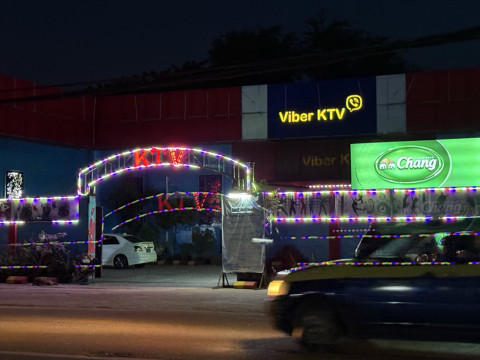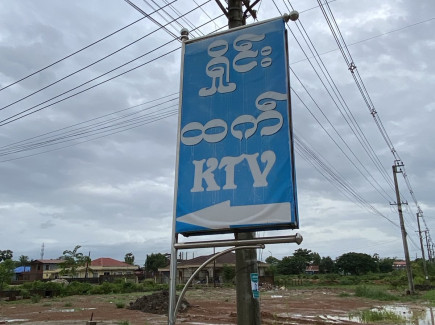Karaoke Bars in Myanmar: Hubs of Injustice and Resilience A Myanmar Commentary by Kira
Topics
Regions
Karaoke bars (KTV) in Myanmar bring together people from all walks of life – for better or worse. This commentary explores the controversy surrounding KTVs and argues that understanding them reveals more than simply judging them ever could.

Elvis P
Karaoke TV (KTV)1 bars are rising in popularity in Myanmar. All over the country, new KTVs pop up nearly every month. The same goes for nightclubs, casinos and other entertainment centres. But these places are mostly seen in a negative light by locals. Since the 2021 military coup especially, people often link KTVs directly to drugs, sex and other vices.
Even so, KTVs are popular in Myanmar. Karaoke in itself is a common go-to entertainment activity for families, friends or colleagues. So what makes KTV controversial? This commentary aims to unpack this by spotlighting the diverse people one might encounter at a KTV.
What is a KTV?
The name speaks for itself. A KTV is essentially a place for karaoke, for singing along to instrumental music, with lyrics displayed on a television screen. A KTV typically offers rooms to rent by the hour. Other services, such as food and beverages, or special event packages, may be available as well.
KTV bars are common in Asian countries. Clients typically come in groups – large or small. They come to rent KTV rooms for certain numbers of hours. Some like to enjoy a few glasses of beer or whiskey, or light bites. This is why many KTV bars are equipped with kitchens, and employ hospitality staff too.
For clients, KTVs are sites of leisure or entertainment. They generate profits for the owners and high-level managers, to whom KTVs are simply business ventures. For the staff, from waiters to technicians to cleaners, KTVs are workplaces.
Who frequents a KTV?
Many people in Myanmar assume that KTVs mainly attract young people. The negative stigma around KTVs and drug use are also commonly associated with the young generation. Yes, many young people go to KTVs and take drugs. But the reality is much more complex than that.
In a recent workshop session on drugs and intersectionality, participants from Myanmar discussed the KTV phenomenon and took a closer look at who is there and why. Let’s zoom in.
Young clients
It is hard to be young in Myanmar. The situation for young people dramatically deteriorated after the 2021 coup by the State Administration Council (SAC). Young people may be either at risk of military conscription2 or struggle to access education or job opportunities due to the ongoing conflict in the country. Many young people are also involved in political activism. But that too comes with immense weight and risks.
No wonder that, for some, KTVs are a temporary release from the pressure of an uncertain life. For many, KTVs are a way to build happy memories with friends that they may not get to see again tomorrow. Unlike public spaces or even one’s homes, KTVs provide secluded spaces – and, to some extent, a sense of privacy – for young people.
According to a local reporter in Mawlamyine, Mon State:
“Among the youth, a popular phrase is ‘Opening a Room’. This refers to renting a KTV room from 10 p.m. to 6 a.m. for around 1 million kyat, where groups gather and use drugs. That one million kyat room is the cheapest – better rooms cost more, according to a young person who attends. While not all KTVs sell drugs outright, their owners allow guests to freely use drugs in their premises, so young people with money prefer using party drugs like E (Ecstasy), K (Ketamine), and ‘Happy Water’ over alcohol and beer, an anonymous youth reported.”3

DPAG
Not only young clients
KTVs attract the young, but not only. Parents may worry or disapprove of their youngsters going to KTVs. But parents too would understand the temporary release that KTVs may provide in times of crises and hardships. In fact, KTVs facilitate leisurely gathering for families, as much as they can serve as social sites for friends or acquaintances.
A middle-aged man comes with his wife and children one evening – singing, laughing and perhaps enjoying a meal. At a different occasion, he returns with his peers, singing as well but perhaps with more beers this time. Even the types of songs sung at these two occasions might differ greatly.
Anyone familiar with Myanmar politics and society knows that interpersonal relationships are key in building trust and cooperation. Those in politics, business or anything in between sometimes invite their guests to KTVs. With food, drinks and music, important relationships – for better or for worse – are built at KTVs.
Those with considerable political-economic power go to KTVs as well: local authorities, leaders of armed groups, business elites. Here is where certain lines may become blurred. Undeniably, drugs – though officially condemned – are also consumed by those in these high positions of power. Drugs are not just for the rich clientele, however. A few rooms away, a group of students may be experimenting with happy water4 or ketamine. According to Myanmar law, both groups are committing illegal acts. But one has more power not to be caught up in the potential legal consequences of such acts.
Workers of various kinds
A KTV cannot function without its workers. Amongst these workers, inequalities and power dynamics exist. Higher up in the chain, there may be a manager, supervisor or a combination of both.
Their job is closely tied to the profit-making interests of the KTV owner or investor. At the moment, KTV business seems to be booming in the country. A KTV manager may deploy tactics to attract clients and bring in as much revenue as possible. They hire staff and ensure that waiters, waitresses, and other workers stay productive. A manager should also know which clients might cause problems and which workers need protection from checkpoints outside.
Many KTV employees work long hours under difficult conditions. Plus, if they are between 18 and 35 years of age, they may live in fear of conscription. These include waiters and waitresses, cleaners, kitchen staff, entertainment workers and many more. Some might be happy to work there. But others are doing what they can to survive or support their families. This may push them to agree to work demands even when they are tired, scared or morally conflicted.
Inevitably, some KTV workers are there for reasons beyond their control. In Myanmar, migration occurs daily. People of all ages and genders flee their homes (sometimes multiple times) due to various disasters, man-made or otherwise. Some end up working at KTVs because other options do not exist or do not pay enough.
Some women may work as waitresses, others as entertainment workers. Waitresses typically serve food and drinks and are not expected to mingle closely with clients. In contrast, entertainment workers – sometimes referred to as ‘bar girls’ – may be hired to accompany clients. Their role can involve singing, drinking or physical contact in exchange for additional fees. While some entertainment workers may engage in sex work, others do not. But sex work also exists on a spectrum and is not always easily defined.
A site of contradiction
The examples above are only the tip of the iceberg. But they are enough to demonstrate the complexity of the KTV phenomenon. KTVs serve as sites of joy and struggle, of commodification and community, of exploitation and resistance. It is where clients, workers, owners, students, authorities and families all gather, albeit with different motives, privileges and risks.
At the same time, the popularity of KTVs reflects the deep importance of music and singing in Myanmar society, especially the act of sharing that experience with others. For some, songs and melodies help voice political grievances or imagine new futures. For others, music creates moments of connection – or simply offers a way to unwind.
Amidst inequality and precariousness, people still seek connection – and even pleasure.
KTV as a microcosm of intersectional injustice and resilience
A KTV bar, it turns out, is a microcosm of the larger social landscape, in which injustice and resilience coalesce. It’s a space where power dynamics, gender roles and even political uncertainty collide. Three main points can be made here.
First, KTVs seem to thrive precisely because of class-based differences. Owners and investors make profits from KTV businesses, and wealthy customers link up with entertainment workers through KTVs. But to do so they rely on managers, and even more so on low-waged workers. The latter often comes with tremendous baggage – of trauma, dispossession and loss due to the multiple crises facing Myanmar today. Women earning a living as entertainment and sex workers may face stigma even from their loved ones.
KTVs even blossom in areas no longer controlled by the SAC, where access to electricity is nearly non-existent, if at all. There, one must rely on diesel generators or solar power – options that are often unaffordable for local residents but within reach for KTV owners. This pattern applies also for scam centres in border areas, which continue operating despite electricity cuts. In both cases, it is the wealthier actors who thrive. Ordinary people are left to bear the brunt of repression.
Second, these class divisions shape another element often tied to KTVs: drugs. The relationship with drugs in the context of KTVs is complex. For some, drugs are a means of leisure and entertainment. For others, they serve as a coping mechanism to deal with harsh working conditions, or the difficulties of life. While many people can regulate their drug and alcohol use and live a healthy live, some people have difficulty in controlling their intake and develop drug and alcohol use-related problems. Meanwhile, there are also less visible actors for whom drugs are a source of profit or much-needed income. All these people may unknowingly take up different corners of one particular KTV bar, in one night.
Finally, KTVs play similar roles as other entertainment venues, such as nightclubs, casinos, bars and restaurants. The pleasure obtained in these spaces might be short-lived, and undoubtedly comes at the expense of oppressed people. But it shows that, in addition to basic needs such as food, shelter and clothing, people’s lives are incomplete without joy and relationships. This holds true even in war-torn countries.
Final reflection
KTVs are multiplying across the country. This often sparks debate and judgment about those who frequent them. Yet rather than focusing solely on what is wrong with KTVs, it may be more revealing to consider what they reflect.
After all, the KTV reflects society itself. It’s a place where people from all walks of life navigate personal struggles and shared realities. It is part of the socio-political fabric of Myanmar, no less than roads and hospitals.
In times of conflict and uncertainty, it's easy to focus only on the big picture. But zooming into places like KTVs shows that everyday spaces can tell profound truths about how people live, survive and relate to each other.